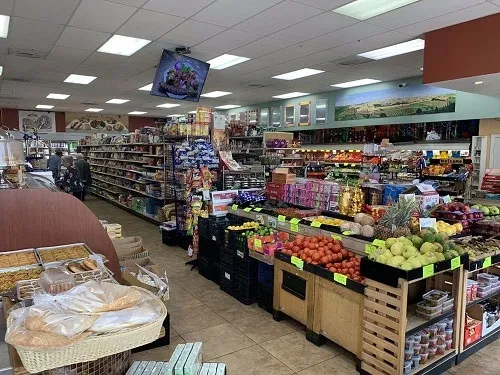A Beginners Guide to Shopping at a Middle Eastern Grocery Store

If you enjoy grocery shopping, a visit to a specialty Mediterranean grocery store is a very enjoyable experience. If you don’t enjoy shopping for groceries, a trip to this kind of store can change your attitude and turn you into a shopping and cooking specialist. It's not tough to get the right ingredients for a Mediterranean meal once you know what to look for in a Middle Eastern market.
Anyone who has shopped for Indian, Chinese and other foreign cuisines knows that cultural differences can make finding what you need a little difficult. While Middle Eastern food is easy to understand and prepare, this guide aims to remove any slight difficulties that a beginner may face.
Meat
Lamb is the meat that Middle Eastern food is known for. Most Middle Eastern markets have special sections devoted to meats of various kinds. Many also have a deli where you can pick up ready-to-eat foods to add to your meal. Besides lamb, beef and poultry are also popular components of a Middle Eastern meal.
Seafood
Middle Eastern food is great for fish lovers as there is a great focus on it. Any kind of fish can be used, although slightly fatty firm-fleshed fish are what are commonly found in the region. Shellfish of all types are also among the staples of the cuisine. Middle Eastern seafood preparation is based on grilling and light frying and if you are not sure which fish to buy, the staff at a Middle Eastern market will be able to help you find the right fish.
Also Read: Why Does the AHA Recommend the Mediterranean Diet?
Dairy
Dairy forms a significant part of Middle Eastern food and among the main components are:
- Labneh: This is a thick yogurt that accompanies many dishes. It can also be drizzled with olive oil and used as a dip with pita bread or as a sandwich spread.
- Laban: This is a variation of labneh and is more like a cream form of Greek yogurt. It is often served along with entrees and its tartness adds to the enjoyment of meats.
- Cheese: There are many varieties of Middle Eastern cheeses. These are eaten either as toppings or as accompaniments to all types of main courses. They can also be enjoyed as standalone side dishes, either with herbs, olive oil and raw or fried vegetables.
For those who are lactose intolerant, the staff at the market should be able to tell you what alternatives you could use.
Spices, Pastes, Oils and Bread
- Spices: The number of Middle Eastern spices can leave anyone confused and at a loss. If you have a recipe, it will have details of the spices to be used. If you are not sure, ask at the market. Tell them what you plan to cook and they will help you find the right spices.
- Tahini: If you have ever had hummus, you have had tahini sauce. Be warned – not all tahini sauces are the same and knowing which one to use for a particular dish can take it from being good to being outstanding. Once again, ask for help if you need it.
- Olive Oil: Olive oil is used in almost all kitchens so most people are familiar with it. When it comes to Middle Eastern cuisine, the best oils are imported and the thumb rule is the darker the oil, the better.
- Pita: Like tahini, pita bread comes in various varieties. Smaller breads are better for dipping while large thin pitas are great for making pita chips.
Also Read: Healthy Foods for Hot Weather
Middle Eastern cooking is easy when you have the right ingredients available. Go to your Middle Eastern market and get what you need to prepare a great meal. Use the deli to pick up readymade accompaniments to add to the variety of the meal.
- Jan 19, 2024
